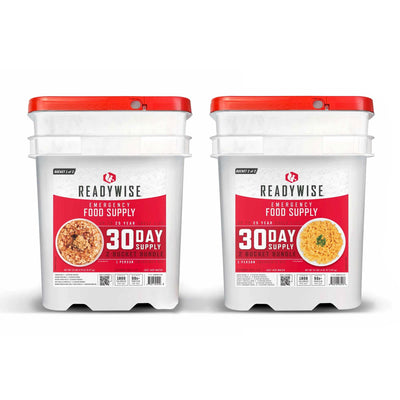In recent years, freeze-dried food has gone from being a space-age solution for astronauts to a popular choice for outdoor enthusiasts, emergency preppers, and even everyday meals. But what exactly is freeze-dried food, and why is it gaining so much attention?
Whether you're putting together a long term food supply or looking for lightweight options for a camping trip, freeze-dried food offers convenience, nutrition, and peace of mind. Understanding how to store food long term is key to ensuring your food remains fresh and ready to use when emergencies arise.
What is Freeze-Dried Food?
The process of freeze-drying food involves removing moisture while preserving the food's nutrients, flavor, and structure. Unlike dehydrated food, which uses heat to remove water, freeze-drying uses a combination of freezing and low pressure. This technique locks in the food's natural qualities, extending its shelf life without compromising its taste or nutritional content.
Compared to methods like canning in regard to canned food or dehydration, freeze-drying is more effective at retaining the original characteristics of the food. It keeps the food's structure intact, so when it's rehydrated, it tastes and feels almost like fresh food. This makes it an excellent option for anyone looking for reliable food storage that doesn't sacrifice quality.
The Freeze-Drying Process
So, how exactly does freeze-drying work? It's a multi-step process that transforms raw food into lightweight, shelf-stable products. Here's how it goes:
- Freezing: The first step involves rapidly freezing the food at extremely low cold temperatures, turning all the moisture into ice.
- Vacuum Pressure: Once frozen, the food is placed in a vacuum chamber where the pressure is lowered, and the ice sublimates (turns directly into vapor) without going through a liquid phase.
- Final Drying: To remove any remaining moisture, the food undergoes a final drying stage, leaving behind a product that's up to 98% moisture-free.
The beauty of the freeze-drying process is that it preserves the structure, texture, and flavor of the food. Whether you're working with fruits, vegetables, or even full meals, this method maintains the food's original form, making it taste fresh once rehydrated. This also explains the popularity of freeze dried apples, berries, and even meat for outdoor adventures or long-term food storage.
Common Types of Freeze-Dried Foods
Freeze-drying can be applied to a wide variety of foods, making it a versatile option for anyone building an emergency food stockpile or planning a hiking trip. Some of the most popular freeze-dried foods include:
- Fruits: Freeze-dried fruits like apples, strawberries, and blueberries are lightweight and retain their natural sweetness and nutrients. They make perfect snacks or can be added to meals.
- Vegetables: Freeze-dried peas, carrots, and green beans are often used in soups, stews, or as standalone side dishes.
- Meats: From raw meat to cooked proteins, freeze-dried meats are famous for their ease of preparation and long shelf life. Just add water, and they're ready to go.
- Full Meals: Many companies now offer freeze-dried meals that include everything from pasta dishes to scrambled eggs, making them a convenient option for emergencies or outdoor adventures.
Whether you're looking to build a comprehensive food storage system or just want some reliable snacks for your next camping trip, freeze-dried options provide variety and convenience. They are also excellent survival foods to stockpile, given their lightweight nature and extended shelf life, making them perfect for emergency preparedness.
Key Benefits of Freeze-Dried Food
Freeze-dried food comes with several standout benefits, making it a go-to choice for those seeking convenience, nutrition, and reliability. Whether you're prepping for emergencies or planning an outdoor adventure, here's why freeze-dried foods should be on your radar.
Long Shelf Life and Storage
One of the main reasons people choose freeze-dried food is its remarkable shelf life—it can last up to 25 years when stored in the right conditions. By removing almost all moisture, the freeze drying process creates an environment that prevents spoilage, bacteria, and mold. For those looking to build a long term food supply, freeze-dried options are ideal because they stay fresh and ready for use far longer than other preservation methods.
But exactly how long does emergency food last? The answer varies based on storage conditions and the type of food, but freeze-dried options offer some of the longest shelf life available.
Retains Nutritional Value and Flavor
Unlike some preservation techniques that strip food of its vital nutrients, freeze-drying maintains the food's nutritional value. This means you're getting all the essential vitamins and minerals without compromise. On top of that, the freeze-drying process locks in the natural flavor, so when rehydrated, the food tastes nearly as good as it did when fresh. Whether it's freeze dried fruits or full meals, you'll enjoy both nutrition and great taste.
Freeze-Dried Food—A Reliable and Versatile Option
In conclusion, freeze-dried food offers a surplus of benefits, from its long-lasting shelf life to its retained nutritional value and lightweight nature. It's a smart choice for anyone building an emergency kit, stocking up on starter kits, or planning for outdoor trips. With its versatility and ease of use, freeze-dried food fits into a variety of scenarios, from everyday meal planning to survival situations.
















































































